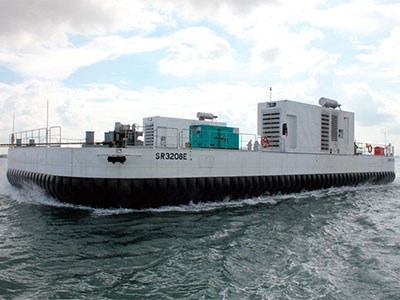While the battle over the mode and route of a fixed transportation link to Northern Ontario’s mineral-rich Ring of Fire drags on, a novel means of transporting construction material and equipment into the remote, waterlogged James Bay lowlands is being proposed by the Sudbury-based Centre for Excellence in Mining Innovation (CEMI).
Hoverbarges, which travel on a cushion of air, can carry hundreds of tonnes of material year-round, unlike ice roads, which can only be used seasonally, according to CEMI president Doug Morrison.
It will take years to build a road or railway to Cliffs Natural Resources’ massive chromite discovery and Noront Resources’ proposed nickel and PGM project 330 kilometres north of Ontario’s existing transportation infrastructure.
Using hoverbarges to transport the vast quantity of construction material and equipment needed for the development of the mines “is a means of making sure the project will move forward before the fixed link is constructed,” said Morrison. Hoverbarges, he added, can also be used to transport material and equipment for the construction of the 30 or more bridges that would be required for a fixed transportation corridor.
Ice roads, he said, won’t suffice for the tonnages required and are increasingly risky due to shortened seasons caused by global warming.
Hoverbarges, manufactured by Singaporebased Hovertrans Solutions, can carry payloads of 50 to 2,500 tonnes.
Self-propelled, diesel-powered versions can carry up to 200 tonnes and travel at a speed of 10 kilometres an hour over muskeg, water and ice. Larger units would be towed by a tractor with oversized balloon tires.
Morrison has met with Cliffs, Noront and De Beers, and is exploring the possibility of tapping into Ontario’s Innovation Demonstration Fund, the federal government’s Sustainable Development Technology Fund and FedNor to fund a demonstration project using a 60-tonne hoverbarge that is “readily available.”
Leasing and operating a hoverbarge for a two-year trial would cost $20 million, said Morrison, while a one-year trial would cost $12 million.
Hoverbarges have primarily been used in wetland areas of the tropics by the oil and gas industry, hence the need to demonstrate their effectiveness in the terrain and climatic conditions of the James Bay Lowlands. The proposed trial would be used to determine the ideal size and figuration of the unit, and resolve any issues relating to noise and refueling.
According to Morrison, the hoverbarges would travel year-round along cleared ice road routes, which would have to be extended to the proposed mine sites from their current points of termination.
Impact on the land is a mere one to two pounds per square inch for a self-propelled hoverbarge and four to five pounds per square inch for a tractor with oversized balloon tires, he noted. In both cases, the impact is less than the seven to eight pounds per square inch attributable to a human being.
Morrison envisions a fleet of different sized hoverbarges, or hovercraft, to meet different needs. Larger units would be used to transport freight, while smaller and faster bus-sized units could be used as an alternative to much more expensive roads to transport people and supplies year-round to remote First Nation communities.
Cliffs’ decision in June to suspend work on the environmental assessment for its Black Thor chromite project and the Ontario Mining and Lands Commissioner ruling in September denying Cliffs’ application for a road easement across mining claims staked by KWG Resources may delay the development of the Ring of Fire, but won’t put a halt to it, said Morrison.
“This is a very major deposit and it will absolutely be mined. The major source of chromite at the present time is South Africa and South Africa has some challenges relating to power and labour unrest. (The chromite in the Ring of Fire) has a whole set of other challenges relating to access, weather, etc., but it’s a very major deposit that will go ahead. It’s just a question of when.”




